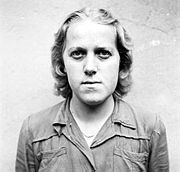
Herta Bothe
Encyclopedia

Early life
Herta Bothe was born in TeterowTeterow
Teterow is a town of Germany, in the district of Rostock, in Mecklenburg-Western Pomerania. Population: 9,535 .The Teterower See is to the north-east of the town.-History:The Stadtkirche St. Peter und Paul Teterow is a town of Germany, in the district of Rostock, in Mecklenburg-Western...
. In 1938 (at age 16) Bothe helped her father in his small Teterow wood shop, then worked temporarily in a factory, then as a nurse in the hospital industry. In 1939 Bothe was a member of the League of German Girls
League of German Girls
The League of German Girls or League of German Maidens , was the girl's wing of the overall Nazi party youth movement, the Hitler Youth. It was the only female youth organization in Nazi Germany....
and excelled athletically.
At Ravensbrück-Stutthof
In September 1942 Bothe was conscripted as a camp guard at Ravensbrück concentration campRavensbrück concentration camp
Ravensbrück was a notorious women's concentration camp during World War II, located in northern Germany, 90 km north of Berlin at a site near the village of Ravensbrück ....
. The former nurse took a four week training course and was sent as an Aufseherin to the Stutthof
Stutthof concentration camp
Stutthof was the first Nazi concentration camp built outside of 1937 German borders.Completed on September 2, 1939, it was located in a secluded, wet, and wooded area west of the small town of Sztutowo . The town is located in the former territory of the Free City of Danzig, 34 km east of...
camp near Danzig (now Gdansk
Gdansk
Gdańsk is a Polish city on the Baltic coast, at the centre of the country's fourth-largest metropolitan area.The city lies on the southern edge of Gdańsk Bay , in a conurbation with the city of Gdynia, spa town of Sopot, and suburban communities, which together form a metropolitan area called the...
). There she became known as the "Sadist of Stutthof." In July 1944 she was sent by Oberaufseherin Gerda Steinhoff
Gerda Steinhoff
Gerda Steinhoff born in Danzig-Langfuhr , was a Nazi concentration camp overseer following the 1939 German invasion of Poland.-SS career:...
to the Bromberg-Ost
Bromberg-Ost
Bromberg-Ost or Konzentrationslager Bromberg-Ost , was the female subcamp of the German concentration camp Stutthof between 1944-1945, in the city of Bydgoszcz....
(Broming East) subcamp.
On January 21, 1945, the 24-years old Bothe accompanied a death march
Death march
A death march is a forced march of prisoners of war or other captives or deportees. Those marching must walk over long distances for an extremely long period of time and are not supplied with food or water...
of women prisoners from central Poland to the Bergen Belsen
Bergen-Belsen concentration camp
Bergen-Belsen was a Nazi concentration camp in Lower Saxony in northwestern Germany, southwest of the town of Bergen near Celle...
concentration camp near Celle
Celle
Celle is a town and capital of the district of Celle, in Lower Saxony, Germany. The town is situated on the banks of the River Aller, a tributary of the Weser and has a population of about 71,000...
. While en route to Bergen-Belsen she and the prisoners stayed temporarily at Auschwitz concentration camp
Auschwitz concentration camp
Concentration camp Auschwitz was a network of Nazi concentration and extermination camps built and operated by the Third Reich in Polish areas annexed by Nazi Germany during World War II...
, arriving at Belsen between February 20–26, 1945.
At Bergen-Belsen
Once in the camp Bothe supervised a female wood brigade of 60 women prisoners. The camp was liberated on April 15, 1945.She is said to have been the tallest woman arrested. Bothe also stood out from other Aufseherinnen because while most of the SS women wore black jack-boots, she was in ordinary civilian shoes. The Allied soldiers forced her to place corpses of dead prisoners into mass graves adjacent to the main camp. She later recalled in an interview some 60 years later that while carrying the corpses they were not allowed to wear gloves and she was terrified of contracting typhus
Typhus
Epidemic typhus is a form of typhus so named because the disease often causes epidemics following wars and natural disasters...
. She said the dead bodies were so rotten that the arms and legs tore away from the rest of the body when they were moved. She also recalled the emaciated bodies were still heavy enough to cause her considerable back pain. Bothe was arrested and taken to a jail at Celle
Celle
Celle is a town and capital of the district of Celle, in Lower Saxony, Germany. The town is situated on the banks of the River Aller, a tributary of the Weser and has a population of about 71,000...
.
At the Belsen Trial
Belsen Trial
The Belsen Trial was one of several trials that the Allied occupation forces conducted against former officials and functionaries of Nazi Germany after the end of World War II...
she was characterized as a "ruthless overseer" and sentenced to ten years in prison for using a pistol on prisoners. She was released early from prison on December 22, 1951 as an act of leniency by the British government.

